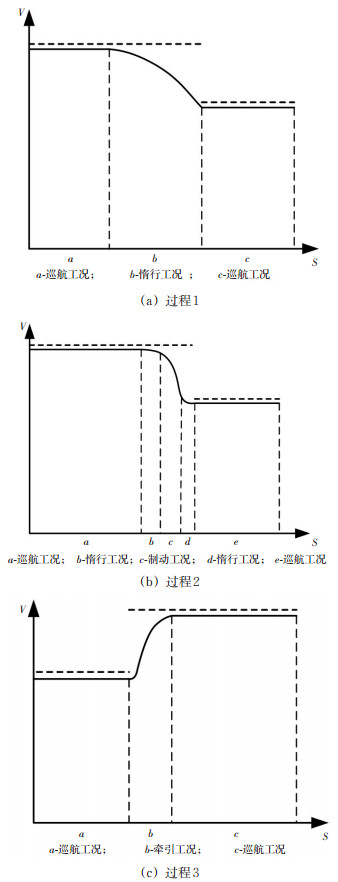An Energy-saving Optimization Method of High-speed Trains Based on Time Deviation Penalty During Train Operation
-
摘要: 合理的安排列车在区间的运行方式能够有效的降低列车运行能耗。采用基于区间限速的列车工况确定策略确定列车区间运行工况, 以列车运行能耗为优化目标, 以列车运行距离、时间和列车限速等为约束条件, 在目标函数中加入列车运行时间偏差惩罚项, 建立基于列车运行时间偏差惩罚的高速铁路列车运行节能优化数学模型, 采用基于高斯变异和混沌扰动的改进人工蜂群算法对优化模型进行求解。以CRH3-350型动车组数据为例对模型与算法进行验证, 求解结果显示: 考虑列车运行时间偏差惩罚比不考虑列车运行时间偏差惩罚能耗可节省2.5%, 改进人工蜂群算法与基本人工蜂群算法、粒子群算法相比, 在目标值方面分别提高了4.2%和4.1%。采用基于区间限速的列车运行工况确定策略结合能耗优化模型能够满足不同限速和不同区间运行时分要求下的列车运行情况。表明所建模型和设计的算法有良好的求解效率和优化质量。Abstract: Reasonable arranging the operation mode of the train in the section can reduce the energy consumption of train operation. A determination strategy of train operating conditions based on the speed limit of the interval is adopted to determine the operating condition of the train. The energy consumption of the train is used as the optimization objective, and the distance, time, and speed limit of the train are used as the constraints. Time deviation penalty during train operation is added to the objective function to develop a mathematical model of energy-saving optimization for high-speed railway train operation, and the improved artificial bee colony algorithm based on Gaussian mutation and chaotic disturbance is used to solve the optimization model. The model and algorithm are verified with CRH3-350 multi-unit data as an example, the solution results show that the energy consumption can be saved by 2.5% when time deviation penalty during train operation is considered. Compared with the basic artificial bee colony algorithm and particle swarm algorithm, the improved artificial bee colony algorithm has improved the target value by 4.2% and 4.1%, respectively. Adopting the determinative strategy based on the interval speed limit combined with the energy-consumption optimization model can meet the required train operation conditions under different speed limits and different intervals. It shows that the established model and the designed algorithm have good problem-solving efficiency and optimized quality.
-
表 1 列车工况转换约束
Table 1. Constraints on the conversion of train-operating conditions
工况 牵引 巡航 惰行 制动 牵引 - √ √ × 巡航 √ - √ × 惰行 √ √ - √ 制动 × × √ - 注:-为相互之间不存在转换关系;√为相互之间可以转换;×为相互之间无法直接转换 表 2 不考虑时间偏差惩罚时粒子群算法求解结果
Table 2. Solution of particle-swarm optimization without considering time deviation penalty
计划工况 牵引 巡航 惰行 巡航 牵引 巡航 惰行 巡航 牵引 巡航 惰行 制动 实际工况 牵引 巡航 惰行 巡航 牵引 巡航 惰行 巡航 牵引 巡航 惰行 制动 步长数量 900 1 678 575 118 257 1 451 415 299 258 1700 409 494 表 3 不考虑时间偏差惩罚时基本人工蜂群算法求解结果
Table 3. Solution of the basic artificial bee colony algorithm without considering time deviation penalty
计划工况 牵引 巡航 惰行 巡航 牵引 巡航 惰行 巡航 牵引 巡航 惰行 制动 实际工况 牵引 巡航 惰行 巡航 牵引 巡航 惰行 巡航 牵引 巡航 惰行 制动 步长数量 911 1 597 699 200 255 1 402 523 247 260 1 548 461 451 表 4 不考虑时间偏差惩罚时改进人工蜂群算法求解结果
Table 4. Solution of the improved artificial bee colony algorithm without considering time deviation penalty
计划工况 牵引 巡航 惰行 巡航 牵引 巡航 惰行 巡航 牵引 巡航 惰行 制动 实际工况 牵引 巡航 惰行 巡航 牵引 巡航 惰行 巡航 牵引 巡航 惰行 制动 步长数量 915 1 718 567 81 139 1 751 415 55 286 1 629 571 427 表 5 不考虑时间偏差惩罚时算法运行结果对比
Table 5. Comparison of the computational result of the algorithm without considering time deviation penalty
算法 运行时间/s 运行能耗/(kW·h) 相比改进人工蜂群算法能耗节省/% 改进人工蜂群算法 1 278.4 660.76 基本人工蜂群算法 1 279.7 689.41 4.2 粒子群算法 1 264.8 689.31 4.1 表 6 算法运行结果对比
Table 6. Comparison of the computational result of the algorithm
运行时间/s 目标值 运行能耗/(kW·h) 考虑时间偏差惩罚时间节省/% 考虑时间偏差惩罚能耗节省/% 考虑时间偏差惩罚 1 286.7 648.77 644.50 未考虑时间偏差惩罚 1 278.4 660.76 660.76 -0.65 2.5 表 7 考虑时间偏差惩罚的改进人工蜂群算法求解结果
Table 7. Solution of the improved artificial bee colony algorithm considering time deviation penalty
计划工况 牵引 巡航 惰行 巡航 牵引 巡航 惰行 巡航 牵引 巡航 惰行 制动 实际工况 牵引 巡航 惰行 巡航 牵引 巡航 惰行 巡航 牵引 巡航 惰行 制动 步长数量 900 1 750 527 126 118 1 706 501 213 267 1 535 492 419 表 8 不同运行时间要求下算法运行结果对比
Table 8. Comparison of computational results of the algorithm under different running time
运行时间/s 运行能耗/(kW·h) 运行时间充裕条件下时间节省/% 运行时间充裕条件下能耗节省/% 最短运行时间条件下 1 278.4 660.76 -1.5 9.1 运行时间充裕条件下 1 297.6 600.35 表 9 运行时间充裕条件下改进人工蜂群算法的求解结果
Table 9. Solution of the improved artificial bee colony algorithm under sufficient running time
计划工况 牵引 巡航 惰行 巡航 牵引 巡航 惰行 巡航 牵引 巡航 惰行 制动 实际工况 牵引 巡航 惰行 巡航 牵引 巡航 惰行 制动 步长数量 900 1 638 579 2 684 200 1 591 535 427 表 10 优化结果对比
Table 10. Comparison of optimized results
% 评价指标 文献[20]优化结果 本文优化结果 运行时间 2 1.5 运行能耗 -10.7 -9.1 -
[1] YANG X, LI X, NING B, et al. A survey on energy-efficient train operation for urban rail transit[J]. IEEE Transactions on Intelligent Transportation Systems, 2015, 17(1): 2-13. [2] SONG Y, SONG W. A novel dual speed-curve optimization based approach for energy-saving operation of high-speed trains[J]. IEEE Transactions on Intelligent Transportation Systems, 2016, 17(6): 1-12. doi: 10.1109/TITS.2016.2564178 [3] 樊葱, 柏赟, 周雨鹤, 等. 考虑过分相区的高速铁路列车操纵节能优化[J]. 交通信息与安全, 2020, 38(4): 25-33. doi: 10.3963/j.jssn.1674-4861.2020.04.004FAN Cong, BAI Yun, ZHOU Yuhe, et al. Optimization of highspeed train control considering neutral zone[J]. Journal of Transport Information and Safety, 2020, 38(4): 25-33. (in Chinese) doi: 10.3963/j.jssn.1674-4861.2020.04.004 [4] KHMELNITSKY E. On an optimal control problem of train operation[J]. IEEE Transactions on Automatic Control, 2000, 45(7): 1257-1266. doi: 10.1109/9.867018 [5] HOWLETT P G. An optimal strategy for the control of a train[J]. Anziam Journal, 1990, 31(4): 454-471. http://pdfs.semanticscholar.org/d1bc/f818883e5c64317a1fabad703b42b05d289f.pdf [6] HOWLETT P G, CHNEG J. Optimal driving strategies for a train on a track with continuously varying gradient[J]. The Journal of the Australian Mathematical Society Series B: Applied Mathematics, 1997, 38(3): 388-410. doi: 10.1017/S0334270000000746 [7] ASNIS I, DMITRUK A, OSMOLOVSKII N. Solution of the problem of the energetically optimal control of the motion of a train by the maximum principle[J]. USSR Computational Mathematics and Mathematical Physics, 1985, 25(6): 37-44. doi: 10.1016/0041-5553(85)90006-0 [8] 曹佳峰. 城市轨道交通列车节能操纵策略研究[J]. 铁道运输与经济, 2019, 41(10): 108-113+118. https://www.cnki.com.cn/Article/CJFDTOTAL-TDYS201910020.htmCAO Jiafeng. A study on the energy-efficient manipulation strategy of urban rail transit train[J]. Railway Transport and Economy, 2019, 41(10): 108-113+118. (in Chinese) https://www.cnki.com.cn/Article/CJFDTOTAL-TDYS201910020.htm [9] JORGEN T H, DAVID P, MOHAMMAD S. A dynamic programming approach for optimizing train speed profiles with speed restrictions and passage points[J]. Transportation Research Part B: Methodological, 2017. [10] 唐海川, 朱金陵, 王青元, 等. 一种可在线调整的列车正点运行节能操纵控制算法[J]. 中国铁道科学, 2013, 34(4): 89-94. doi: 10.3969/j.issn.1001-4632.2013.04.15TANG Haichuan, ZHU Jinling, WANG Qingyuan, et al. An online adjustable control algorithm for on-time and energy saving operations of trains[J]. China Railway Science, 2013, 34(4): 89-94. (in Chinese) doi: 10.3969/j.issn.1001-4632.2013.04.15 [11] MASAFUMI M, HIDEYOSHI K, et al. Optimization of train speed profile for minimum energy consumption[J]. IEEJ Transactions on Electrical and Electronic Engineering, 2010, 5(3): 263-269. doi: 10.1002/tee.20528 [12] 杨辉, 李莹, 周艳丽. 基于APSO的地铁节能运行速度优化研究[J]. 铁道科学与工程学报, 2020, 17(8): 1926-1934. https://www.cnki.com.cn/Article/CJFDTOTAL-CSTD202008006.htmYANG Hui, LI Ying, ZHOU Yanli. Research on optimization of energy-saving operation speed of metro based on APSO[J]. Journal of Railway Science and Engineering, 2020, 17(8): 1926-1934. (in Chinese) https://www.cnki.com.cn/Article/CJFDTOTAL-CSTD202008006.htm [13] 黄友能, 宫少丰, 曹源, 等. 基于粒子群算法的城轨列车节能驾驶优化模型[J]. 交通运输工程学报, 2016, 16(2): 118-124+142. doi: 10.3969/j.issn.1671-1637.2016.02.014HUANG Youneng, GONG Shaofeng, CAO Yuan, et al. Optimization model of energy-efficient driving for train in urban rail transit based on particle swarm algorithm[J]. Journal of Traffic and Transportation Engineering, 2016, 16(2): 118-124+142. (in Chinese) doi: 10.3969/j.issn.1671-1637.2016.02.014 [14] 陈昱, 侯涛, 杨宏阔. 基于双重优化的高速列车节能运行研究[J]. 铁道运输与经济, 2020, 42(7): 103-108. https://www.cnki.com.cn/Article/CJFDTOTAL-TDYS202007019.htmCHEN Yu, HOU Tao, YANG Hongkuo. A study on energy-saving operation of high-speed trains based on double optimization[J]. Railway Transport and Economy, 2020, 42(7): 103-108. (in Chinese) https://www.cnki.com.cn/Article/CJFDTOTAL-TDYS202007019.htm [15] 周翔翔, 刘鑫荣, 张永, 等. 基于遗传优化算法的城市轨道交通多列车运行节能计算方法[J]. 城市轨道交通研究, 2018, 21(12): 67-70. https://www.cnki.com.cn/Article/CJFDTOTAL-GDJT201812021.htmZHOU Xiangxiang, LIU Xinrong, ZHANG Yong, et al. Calculation of energy saving in multi-vehicle operation based on genetic optimization algorithm[J]. Urban Mass Transit, 2018, 21(12): 67-70. (in Chinese) https://www.cnki.com.cn/Article/CJFDTOTAL-GDJT201812021.htm [16] 汤旻安, 王茜茜. 基于黄金比例遗传算法的动车组列车节能优化研究[J]. 铁道科学与工程学报, 2020, 17(1): 16-24. https://www.cnki.com.cn/Article/CJFDTOTAL-CSTD202001003.htmTANG Minan, WANG Qianqian. Research on energy-saving optimization of EMU trains based on golden ratio genetic algorithm[J]. Journal of Railway Science and Engineering, 2020, 17(1): 16-24. (in Chinese) https://www.cnki.com.cn/Article/CJFDTOTAL-CSTD202001003.htm [17] 王青元. 高速列车准点节能优化操纵研究[D]. 成都: 西南交通大学, 2017.WANG Qingyuan. Energy-efficient control of high-speed trains considering punctuality constraint[D]. Chengdu: Southwest Jiaotong University, 2017. (in Chinese) [18] 马晓娜. 基于萤火虫算法的高速列车节能运行优化研究[D]. 兰州: 兰州交通大学, 2019.MA Xiaona. Energy-saving optimization of high-speed train operation based on firefly algorithm[D]. Lanzhou: Lanzhou Jiaotong University, 2019. (in Chinese) [19] 李娇杨, 陈光武. 基于改进遗传算法的高速列车节能优化研究[J]. 铁路计算机应用, 2021, 30(3): 5-9. doi: 10.3969/j.issn.1005-8451.2021.03.002LI Jiaoyang, CHEN Guangwu. Energy saving optimization of high-speed train based on improved genetic algorithm[J]. Railway Computer Application, 2021, 30(3): 5-9. (in Chinese) doi: 10.3969/j.issn.1005-8451.2021.03.002 -





 下载:
下载:









